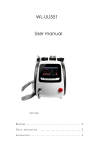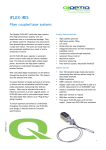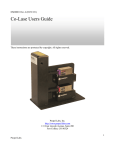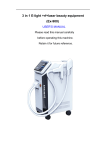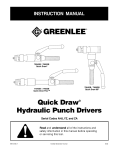Download user manual 170xl visual fault finder
Transcript
Cleaning EC Declaration of Conformity Cleaning the Output Port We, Cleaning all connectors before coupling them to the 170XL visual fault finder will ensure proper maintenance of the output port and laser lens. Users should always cover the output port with the dust cap when the instrument is not in use. If binding or stickiness is felt when inserting connectors into the output port, the ceramic sleeve should be cleaned. To clean the sleeve, insert a Tempo 946 cleaning wand into the output port until it stops. Twist the wand, remove it, and discard. Do not reuse the cleaning wand. Greenlee Textron Inc. 4455 Boeing Drive Rockford, IL 61109-2988 U.S.A declare under sole responsibility that the 170XL visual fault finder laser source, manufactured in the United States of America, meets the intent of the directive 89/336/EEC for electromagnetic compatibility. Compliance was demonstrated to the following specifications as listed in the official Journal of the European Communities: EN 50081-1, Emissions: EN 55022 EN 55022 EN 60555-2 Radiated, Class B Conducted, Class B Power Harmonics EN 50082-1, Immunity: IEC 801-2 IEC 801-3 IEC 801-4 IEC 801-5 Electrostatic Discharge RF Radiated Fast Transients Surge Cleaning the Laser Lens If the intensity of the light output decreases considerably, despite the batteries being in good condition, the laser lens is probably dirty. Loose dirt can be removed by applying suction to the output port. NOTE: Do not blow air into the output port to remove dirt particles. Doing so will only pack the dirt and make it harder to remove. If the lens is extremely dirty, flush out the output port with a small amount of reagent-grade isopropyl alcohol, then apply gentle suction to remove any remaining dirt. Make sure that all residual alcohol has evaporated before resuming testing. Specifications Light source Central wavelength: Nominal Range (typical) Spectral width Peak power output 1, 2, 3: Into SMF-28 fiber, CW or MOD output mode Maximum emitted power MOD output frequency Power requirements Battery life Connector interface CDRH Environmental: Operating temperature Storage temperature Humidity Weight and dimensions 635nm red laser diode and monitor, with multi-quantum well structure 635nm 630nm to 640nm < 2nm 1.0mW (0dBm) maximum 316µW (-5dBm) minimum 2.0mW < 3Hz, approximate Two (2) 1.5V alkaline batteries Approx. 48 hrs. continuous operation 2.5mm “quick connect” port 2, or 16-series SOC adapters Class IIIa -10°C to +50°C -40°C to +60°C 0 to 95% RH, non-condensing 22.9 x 2.54cm (9 x 1 in.) 200g (7 oz) with batteries and pouch 170XL VISUAL FAULT FINDER Warranty Information Greenlee warrants this product to be free from defects in material and workmanship for a period of one (1) year from the date of shipment. During the warranty period we will, at our option, either repair or replace any product that proves to be defective. To exercise this warranty, write or call your local Greenlee representative, or contact Greenlee directly. You will be given prompt assistance and return instructions. Send the instrument, transportation prepaid, to the indicated service facility. Repairs will be made and the instrument will be returned, transportation prepaid. Repaired products are warranted for the balance of the original warranty period, or at least 90 days. Limitation of Warranty This warranty does not apply to defects resulting from unauthorized modification or misuse of any product or part. This warranty is in lieu of all other warranties, expressed or implied, including any implied warranty of merchantability or fitness for a particular use. Greenlee shall not be liable for any indirect, special, or consequential damages. Notice of Proprietary Rights The design concepts and engineering details embodied in this manual, which are the property of Greenlee, are to be maintained in strict confidence. No element or detail of this manual is to be spuriously used, nor disclosed without the express written permission of Greenlee. All rights are reserved. No part of this publication may be reproduced, stored in a retrieval system, or transmitted in any form or by any means, electronic, mechanical, photocopying, recording, or otherwise, without prior written permission from Greenlee. COPYRIGHT © 2005 BY GREENLEE ALL RIGHTS RESERVED. FIRST EDITION 2005 PRINTED IN THE UNITED STATES OF AMERICA 1 Within specified ambient environment of +20°C to +25°C. 2 APC-type ferrule coupling efficiency reduced by > -3dBm. 3 Output power with beam collimator may exceed 1mW. Product complies with CDRH Class II, 1mW max. without collimator accessory and IEC 825-1: 1993, 5mW max. Greenlee Textron Inc. 4455 Boeing Drive Rockford, IL 61109-2988 U.S.A USER MANUAL www.greenlee.textron.com 97-0170-67 Rev A Using the Beam Collimator Product Description Operation The Greenlee 170XL visual fault finder is a pocket-sized, rugged, and splash proof handheld instrument incorporating a stabilized, high output 635nm laser diode. Providing up to 48 hours of continuous operation using two AA-size alkaline batteries, the 170XL can clearly locate breaks and bending losses in optical fibers up to 3km in length. A rotary switch on the instrument permits the user to select between continuous wave (CW) and a blink (MOD) mode that increases viewing contrast, or to switch the instrument off with one hand. The 170XL is fitted with a universal “quick connect” output port that enables convenient temporary coupling with all 2.5mm fiber optic connectors. The instrument can also be used with optional 16-series Snap-On Connector (SOC) adapters, which permit secure coupling with industry standard fiber optic interfaces. In addition, an optional beam collimator adapter permits testing of multipin interfaces, such as Deutsch Ltd. ruggedized connectors, without the need for disassembly. Controls and Indicators Standard Contents 1) Insert the ferrule of a fiber optic connector into the “quick connect” output port, ensuring that it seats completely. The user should always clean the end face of the connector before inserting it in the “quick connect” output port. 2) Rotate the switch to the desired operating mode by moving it to the right. The first position puts the instrument in continuous wave (CW) mode. The second position puts the instrument in blink (MOD) mode. The LED indicator on the unit will illuminate steadily in CW mode. It will blink in MOD mode. 1 1 1 2 170XL visual fault finder Nylon carrying pouch User manual 1.5V alkaline batteries Using the 2.5mm “Quick Connect” Output Port Optional Accessories 16-series Snap-On Connector (SOC) adapters Beam collimator assembly 946 adapter cleaning wands (for cleaning output port) 3) See the Applications section for instructions on tracing faults in optical fibers. Battery Installation/Replacement Using a 16-Series SOC Adapter The 170XL visual fault finder is shipped without the batteries installed. The two AA-size alkaline batteries shipped with the instrument must be installed before use. Greenlee does not recommend the use of non-alkaline or rechargeable batteries in the instrument. Optional 16-series Snap-On Connector (SOC) adapters are available for FC, SC, ST, and DIN fiber optic connectors. SOC adapters fasten secure to fiber optic connectors and prevent them from pulling loose from the instrument. To use a 16-series SOC adapter with the 170XL, do the following: NOTE: If the LED indicator appears dim during operation, it is time to replace the batteries in the unit. 1) Select the appropriate 16-series SOC adapter and snap it over the “quick connect” output port. 2) Insert the connector under test into the adapter and secure it. Most fiber optic connectors are secured by turning the outer sleeve clock wise. 3) Rotate the switch to the desired operating mode. 4) See the Applications section for instructions on tracing faults in optical fibers. NOTE: 10-series SOC adapters cannot be used on the 170XL visual fault finder, as they are larger in diameter. To install or replace the batteries, do the following: 1) 2) 3) 4) Make sure the rotary switch is in the OFF position. Unscrew the end cap by turning it counterclockwise, then remove the used batteries, if any. Insert two new AA-size alkaline batteries positive end first, as shown in the above illustration. Replace the end cap, turning it clockwise to tighten it in place. WARNING: Do not look directly into the output port when the instrument is ON. Never use a viewing instrument such as a magnifier or microscope to view the free end of any optical fiber connected to the T170XL visual fault finder. The use of viewing on active fibers can focus an intense laser beam onto the retina of the eye, resulting in permanent damage or blindness. Always aim the free end of an active fiber at a non-reflective surface. The optional beam collimator concentrates the laser output from the 170XL visual fault finder, eliminating the need for a physical connection when conducting tests. The beam collimator is especially useful when testing female multi-pin connectors. While the beam collimator can also be used to test male multi-pin connectors if held steadily in the hand, this may be impractical in the field. Greenlee recommends using a FoPro™ fiber optic probe for testing the male end of multi-pin connectors. CAUTION: Do not stare into the collimated beam, or view it using a magnifying instrument. The laser output may exceed 1mW when using the beam collimator. 1) 2) 3) 4) Snap the beam collimator over the “quick connect” output port. Rotate the switch to the desired operating mode. Aim the collimated beam into the receptacle under test. See the Applications section for instructions on tracing faults in optical fibers. Applications The 170XL visual fault finder is designed to quickly locate breaks in optical fibers. Any interruption in continuity will be indicated by red light escaping from the fiber. Light can also escape from the fiber if it is stressed or bent too tightly. In either case, escaping light is a sure sign of a problem. The 170XL visual fault finder can also be used to check the condition of ceramic ferrules. A fiber break inside, or past, the ferrule will make it glow. If the entire connector glows, it is definitely bad. A glowing ferrule can also indicate a bad end face polish. If the end face polish is bad, light in the fiber will be reflected internally and be visible through the ferrule.





